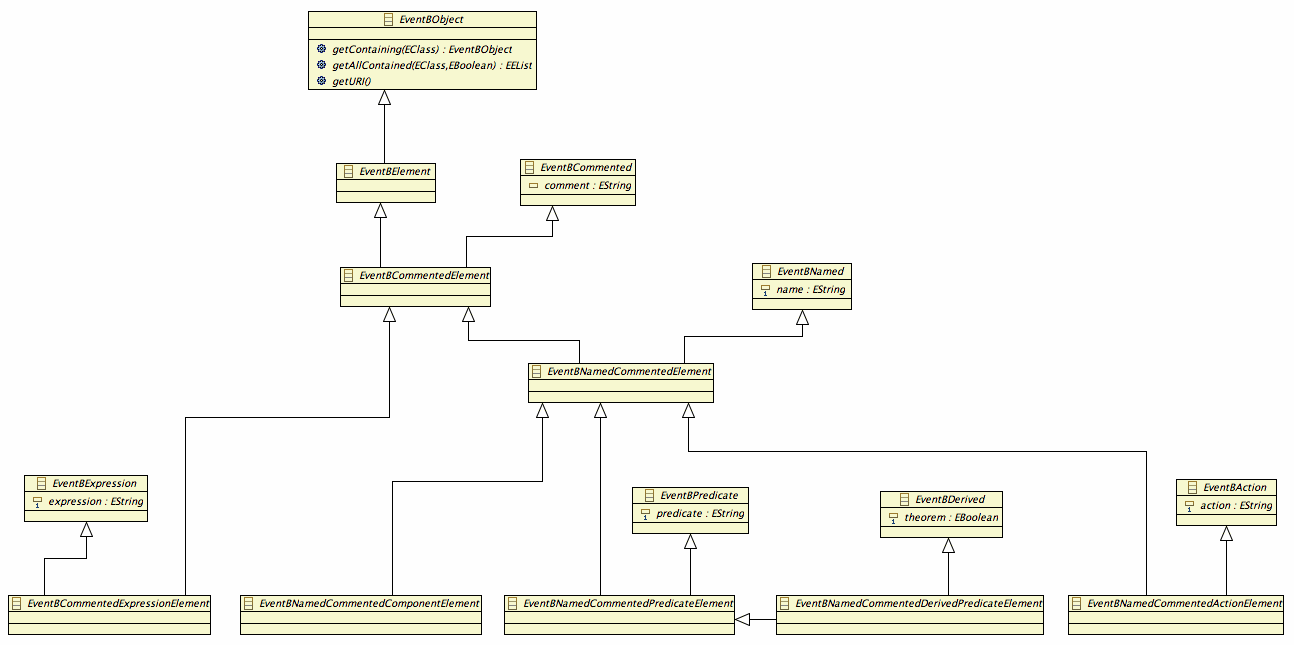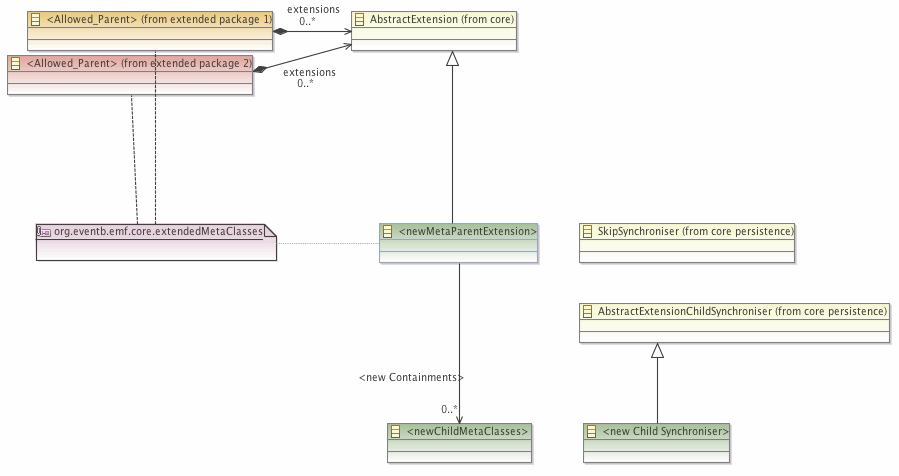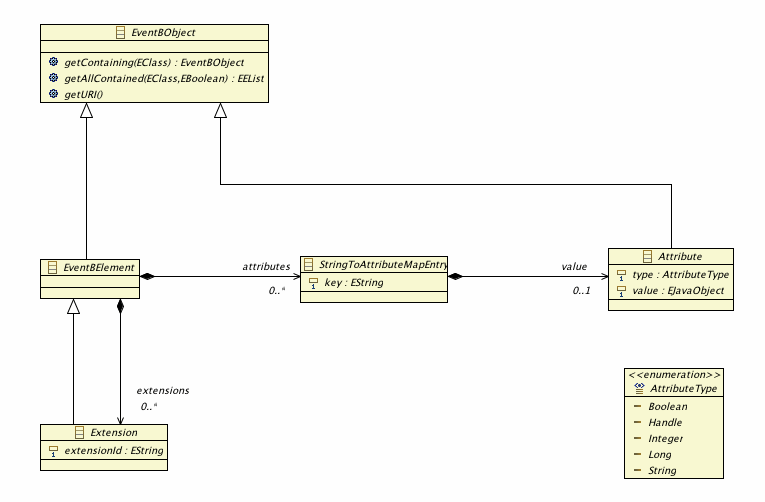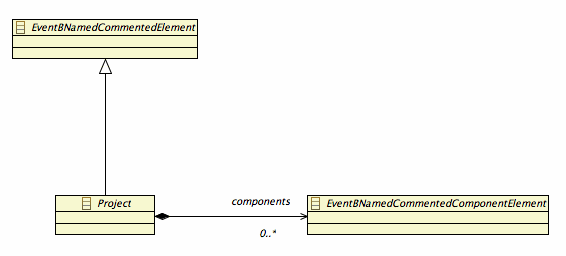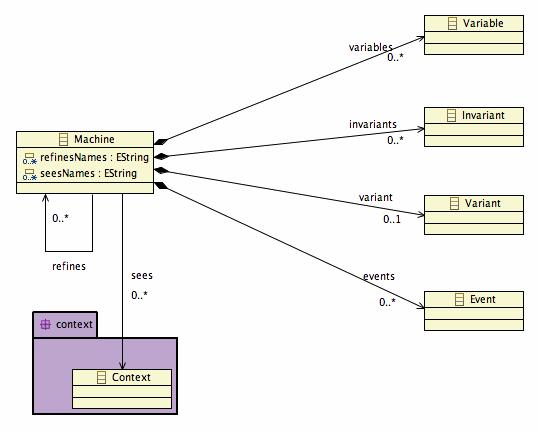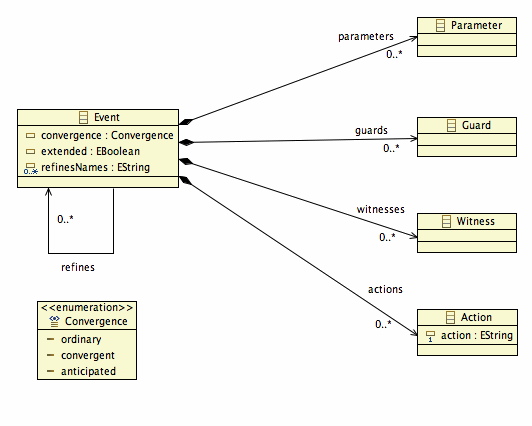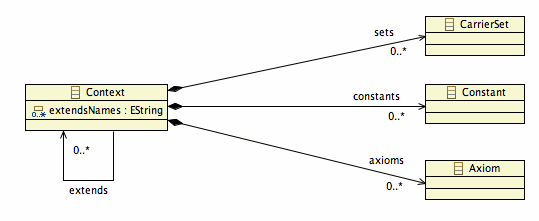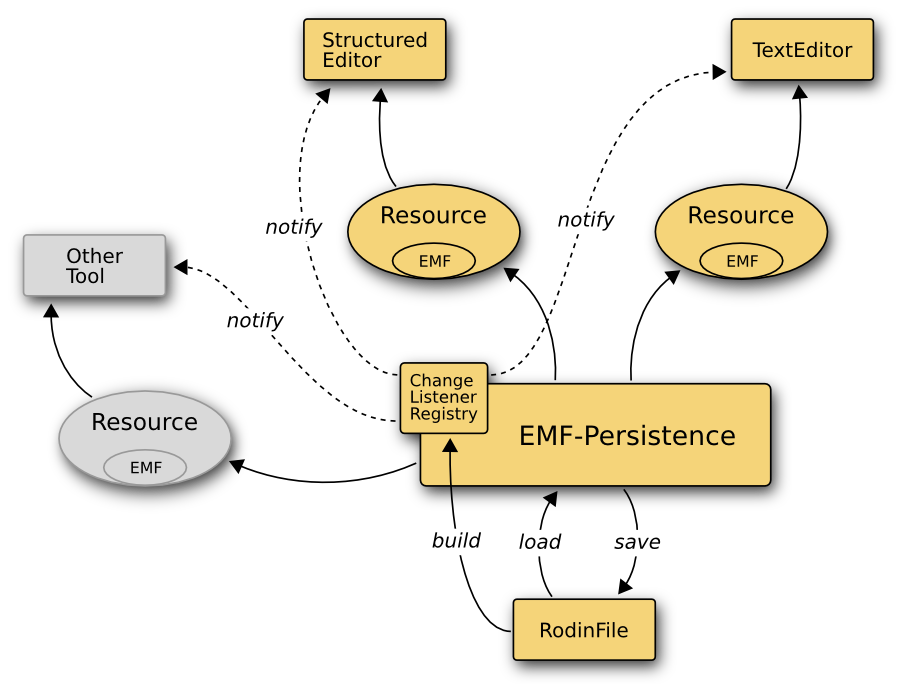EMF framework for Event-B
This page describes the core facilities for loading Rodin Event-B models in EMF and the 'hooks' that are provided for making extensions. Further support for extending the Event-B modelling language is available here: Generic Event-B EMF extensions.
A generic EMF to EMF translator is also available. This can be configured to generate Event-B EMF and is used for some more recent Event-B generators. It will eventually replace the generator that only targets Event-B. The generic translator can be used between any source-target pair of EMF meta-models. It is described here: EMF to EMF model translator.
The Eclipse Modeling Framework
The EMF project is a modeling framework and code generation facility for building tools and other applications based on a structured data model. From a model specification, EMF provides tools and runtime support to produce a set of Java classes for the model, along with a set of adapter classes that enable viewing and command-based editing of the model, and a basic editor.
An EMF Meta-Model of Event-B
The Event-B meta-model defines the structure of Event-B projects. The model is structured into three packages for clarity. The core package contains a structure of abstract meta-classes so that models can be treated generically as far as possible. The core package also contains mechanisms to handle extensions provided by other plug-ins and a meta-class to model entire projects. There are two sub-packages, contained with the core package, for Machine and Context. Note, that the EventB prefix is used to indicate that a meta-class is abstract (i.e. cannot be instantiated except via one of its subclasses).
Abstract Basis
The meta-model is built upon a structure of abstract meta-classes. (Abstract meta-classes are ones that cannot be directly instantiated. Their instances are always instances of one of their concrete sub-meta-classes). These abstract meta-classes are useful because they enable a feature to be defined once in the meta-model and be used, via inheritance, by many concrete meta-classes. Apart from making it easier to maintain the meta-model, this makes it possible to write code that is more generic, since it can work on features without knowing which concrete meta-class the instance it is working on belongs to. To easily distinguish abstract meta-classes from concrete ones, we prefix abstract meta-classes with EventB. For abstract classes, we also follow the convention of including within the name, all the features that are inherited by that meta-class. For example, EventBNamedCommentedElement inherits from EventBCommentedElement and from EventBNamed. The abstract meta-classes which are to be used to define concrete meta-classes are arranged in a hierarchy. Each feature is contained in a meta-class outside of this hierarchy (e.g. EventBNamed). This provides a flexible choice of how to access model objects, either at a point in the hierarchy to generalise over parts of its structure or via the feature containers to generalise over all elements that may own that feature. (Although currently these are equivalent, this may not always be the case).
The root of all meta-classes in the Event-B EMF model is the abstract base class, EventBObject this provides some convenience methods to access containing or contained elements of a specified type and a method to obtain the URL of an element's package. EventBObject extends the EMF class, EObject and provides a collection of Annotations. Annotations (which are similar to Ecore's EAnnotations ) give a flexible and efficient way to store information that is not part of the main model. For example this is used to store some information contained in the Rodin database, which must be preserved but is not of interest in the EMF modelling tools.
EventBElement provides a common abstract base class for all EventBObjects that are elements of the model. This meta-class provides extensibility features that are described later.
EventBCommentedElement provides the ability to comment elements. It inherits a string attribute, comment from EventBCommented. (The use of a separate meta-class, outside the main inheritance hierarchy gives more flexibility for future modifications if other elements need to be commented. Hence if client code refers to comments via EventBCommented rather than EventBCommentedElement they will not be affected if, in the future, other elements inherit EventBCommented).
Similarly, EventBNamedCommentedElement adds the ability to name elements by inheriting a string attribute, name from EventBNamed. (Currently, a named but not commented element is not provided).
EventBCommentedExpressionElement provides a string attribute, expression (inherited from EventBExpression), for an Event-B mathematical expression. Note that our current need (Variant) is for expression elements to be commented but not named.
EventBNamedCommentedComponentElement subtypes EventBNamedCommentedElement to provide a common basis for any components (Machines, Contexts etc.) that are contained in the Event-B Project.
EventBNamedCommentedPredicateElement provides a string attribute, predicate (inherited from EventBPredicate), for an Event-B mathematical predicate. Note that our current need is for all predicate elements to be commented and named.
EventBNamedCommentedDerivedPredicateElement extends EventBNamedCommentedPredicateElement and provides a boolean attribute, theorem (inherited from EventBDerived to indicate that the predicate is a theorem that should be derived (from previous predicates in the same container).
EventBNamedCommentedActionElement provides a string attribute, action (inherited from EventBAction), for an Event-B mathematical substitution.
Extensibility Mechanism
The Extensibility mechanism caters for extensions (i.e. new elements and/or attributes) that have been defined in the Rodin database. When Rodin does not need to understand the extension, a mechanism is provided to persist the extension as a string attribute in a generic Rodin element. This saves having to define an equivalent Rodin database extension. The extension mechanism can also be used to store temporary volatile modelling data that will not be persisted. The extensions will only be persisted if valid Rodin identifiers are provided.
The extension data is contained by the abstract meta-class EventBElement and hence can be attached to any Event-B model element. Two mechanisms are provided, one for simple attributes (corresponding to Rodin attribute extensions) and one for extension elements (corresponding to Rodin element extensions).
Attribute extensions are contained in a collection attributes. They utilise an intermediate StringToAttributeMapEntry class which triggers the EMF generator to provide the collection as a special kind of list that can be accessed also as a map. If persistence is required the map key, contained in the StringToAttributeMapEntry class, should be a valid Rodin extension id; and the map value should be an Attribute with type (an enumeration corresponding to the Rodin attribute types) and value fields (a java object allowing for different attribute types). This feature is used in the following way:
- if, at load time, a Rodin attribute is found that is not recognised as a known attribute of the current element type, the attribute will be stored in the generic attributes collection using its type identification as the key. Such unknown attributes will be restored at save time.
- all elements of an unknown extension element are treated in this way.
- if at save time, any extensions are found that do not have a valid Rodin extension identifier as their attribute map key, these will be assumed to be volatile and will be discarded.
Element extensions are represented by a collection, extensions, of a meta-class, AbstractExtension, which has an extensionId. This mechanism can be used in several ways. A new meta-class can extend the core meta-class AbstractExtension so that it may be added to the 'extensions' containment of any EventBElement. This new meta-class may then be treated in one of the following ways.
- It may be viewed as an extension of the containing parent element so that it contributes new containments to an existing meta-class. To do this it should be given an EAnnotation with source org.eventb.emf.core.ExtendedMetaClasses and references to the extended parent classes should be added to this annotation. For synchronisation, the new extension meta-class should be configured to use the 'ExtensionSynchroniser' from the core's persistence plug-in. (No Rodin element identifier should be given). The children of this extension should specify a new synchroniser that extends 'AbstractExtensionChildSynchroniser' to ensure that loading the corresponding Rodin element constructs the intermediate Extension class.
- It may be viewed as a child element of the parent. In this case, it should be configured with a synchroniser that extends AbstractSynchroniser.
- If Rodin doesn't need to understand the contents of the extension, the extension element should be configured to use the SerialisedExtensionSynchroniser. In this case the extension will be persisted in EMF XMI format in a single attribute of the generic Rodin Element kind, SerialisedExtension. For example, this mechanism is used for making diagrammatic modelling extension.
The following generic fallback mechanisms are also supported:
- if a synchroniser has not been registered; at load time, unknown Rodin elements will be instantiated as generic Extension elements and their attributes will be contained in this element's attributes collection. (Note that the Extension element could contain further recognised or unrecognised elements, which would be added to it's extensions collection). At save time, these elements would be converted back to their corresponding Rodin elements using the extensionId and attribute map key, which are also the Rodin extension identifiers.
- if at save time, any extensions are found that do not have a valid Rodin extension identifier as their extensionId, these will be assumed to be volatile and will be discarded.
Extensions are proxy-resolving so that the possibility of extensions being in separate files is allowed. Of course, they may also be within the same resource.
Further support for Generic Event-B EMF extensions is available.
Project
Event-B projects are modelled in the Event-B EMF model. This provides support for tools that can display and/or manipulate the project contents. A Project contains a collection of components. Project extends EventBNamedCommentedElement. This allows it to contain extensions and attributes as well as providing it with a name and comment. Since persistence works at the component level, the project containments are 'across-resource'. Hence EMF's support for proxy resolution in containments is utilised for the project level model. (By default, proxy resolution is only provided for reference relationships).
References between components
Event-B projects contain references between elements that are contained within different components. Serialisation (persistence) is performed on a per component basis and therefore, these references must work between resources. The default mechanism for this in EMF is for the reference to be represented by a proxy, initially, after loading the component. The proxy URI is resolved when the reference is first accessed. Resolving a proxy results in the referenced component being loaded so that its contents are accessible. We wish to support this established kind of behaviour for tools that need to work at a multi-component level.
However, we also wish to support tools that work on a single-component level that may involve editing the references. The user view of a reference is of a text string that contains the name identifier of the referenced element. The user may edit this identifier to a new name that may or may not exist. The edit may be made without attempting to resolve the proxy so that the validity of the reference is not tested. (When the component containing the reference is saved, the Rodin static checker will check that the reference exists and raise an error if it does not).
In order to support these dual access methods, we have implemented the following EMF features:
- The name attribute of EventBNamed has been designated as an ID. This setting enables EMF's facility for using Intrinsic IDs instead of the default method of indexing collections. As a result of this, proxies are constructed from the URI of the containing resource with the fragment part being the element name.
- The primary feature for a relationship is an EMF reference whose type is the meta-class of the referenced element (i.e. the normal reference relationship used in EMF models). All such references are multiplicity-many, even if only one reference is ever used.
- Resource URI's are constructed lazily when they are resolved. This means that a new reference can be added with just the name of the referenced element. A dummy URI is used to hold the fragment. When the proxy is resolved, the dummy fields are replaced with valid fields derived from knowledge about the structure of Event-B projects. (For example a refined machine must be in the same project as the referencing machine and must have file name given by the reference and extension "bum".
- In order to avoid resolving proxies unnecessarily, elements that can be referenced have been customised so that their getName() method returns the URI fragment if they are a proxy.
- A derived feature which is a list of the reference names is also provided in each referencing element. This has no storage and is constructed from the URI fragments and returned whenever it is requested (by calling getXXXNames() (where XXX is the name of the primary reference feature). The returned list of names is a notifying list so that it will notify the parent element if any changes are made to it. The notification for changes to these lists performs appropriate changes to the primary references feature. For example, adding a new name to the list will add a proxy to the primary reference feature that consists of a dummy URI with fragment equal to the new name.
- The persistence is customised to serialise the list of reference names and discard the list of proxies. (It may seem perverse, then, that the list of names is derived from the proxies. However, this is necessary since the proxies contain more information in memory when they have been resolved and therefore cannot be derived from just the list of names).
- For convenience a method has been added to EventBObject to return its URI. If the element is a proxy, the proxyURI is returned. Otherwise the URI of the component's resource is returned.
Note that the lazy construction of a URI relies on the root element name being used as the resource name. If the name of the root element is changed, it will change the resource name and break any references to it. (If the element name is changed in an editor that works at a higher level than the resource, the editor should update the references automatically)
Machine package
A Machine inherits from EventBNamedCommentedComponentElement (so that it can be used in the components collection of a Project). Machines, refine other machines , see contexts and may contain, variables, invariants, a single variant and events.
Events
An Event contains a refines relationships with other events. It also contains collections of parameters, guards, witnesses, and actions. The enumerated type, Convergence, provides the values for the convergence property of an event.
Context package
A Context inherits from EventBNamedCommentedComponentElement. Contexts, extend other contexts and contain sets, constants and axioms.
Persistence
The Persistence plug-in org.eventb.emf.persistence overrides EMF's default XMI persistence so that models are serialised in the Rodin Database. The serialisation uses the Rodin API so that it is decoupled from the actual serialisation of the Rodin database. The Persistence API provides methods to open/create Rodin projects, load and unload components (from Rodin Database to cache), save changes, and register listeners to projects and components. An extension point is provided for offering synchronisers for new element kinds (extensions).
Persistence takes a rewriting approach. That is, it is more efficient to clear the contents of a model component (machine or context) and regenerate it than to calculate what has been changed and only save the changes. Rodin uses an internal element naming scheme so that tools can uniquely identify elements even if the user has incorrectly labelled two elements by the same name. (This is different form the name, label or identifier visible to the user). The persistence mechanism preserves and re-uses internal names of elements from before the model was loaded. Elements that have been created in EMF (and therefore don't have an internal name already) are given a unique name using EMF's UUID facility. Since the Rodin naming approach is very different from UUIDs there is very little chance of a UUID clashing with a Rodin generated name. However, if this does happen the persistence will detect it and rename one of the elements using a new UUID. In this case a warning is logged in the Plugin error log.
Event-B Mathematical Language Extension
Using the Extension mechanism an EMF extension for the Mathmetical Language of EventB will be created. This means expressions, predicates and substitutions will be available as EMF models too.
As the RodinDB only saves these constructs as plain strings, their EMF representation will be recreated every time a model is loaded. The existing RodinParser in combination with a conversion component will be used for this task. To avoid unnecessary parsing the creation of these models will be postponed until the models are needed. For example, it will be up to the tool developers to decide when they need a fully resolved structure of predicates. API methods in the Text Tools will ease parsing and model construction for tool developers.
Text Tools
As several tools based on the EventB meta-model will deal with a textual representation of it, a component called 'Text Tools' will be created. Text Tools will offer an API for basic tasks such as:
- Define a concrete syntax for the structure of machines and contexts
- Conversion from an EventB meta-model to text, i.e., pretty-print with configurable layout
- Parsing of text input which produces an EventB meta-model
Structural parsing
The Rodin core already provides a parser for expressions, predicates and substitutions. Therefore Text Tools will only provide a parser for the structural parts of the text representation of EventB machines and contexts. This parser will treat expressions, predicates and substitutions as plain strings that are stored in attributes in the meta-model. As described in section Event-B Mathematical Language Extension the full mathematical language will be supported as an extension to the EventB meta-model. Tools that are interested in working on a fully parsed version of an expression, predicate or substitution will be able to use helper methods of the Text Tools API. These helper methods will make use of the existing Rodin parser and convert the resulting AST to the meta-model.
Fallback strategy
When the user is editing the textual representation of a machine or context the input may contain syntactic errors which prevent converting the parse result into an EMF model. As the user might wish to save the text representation in this syntactically incorrect state, Text Tools will provide a fallback strategy for this case. API methods will be provided to store the plain text into the RodinDB. This plain text will be used as a basis for editing next time the model is loaded via Text Tools.
Conflict resolution
When Text Tools loads an EventB meta-model from the Rodin Database it will detect any conflicts in the model. Conflicts will occur if other editors, that do not work via Text Tools, have changed the model in the RodinDB after Text Tools has stored a syntactically incorrect version as plain text. In this case the tool that is using Text Tools to load the model will be informed about the conflict and asked to resolve it. Strategies to solve these conflicts could be 'automatic overwriting based on time stamps' or using the editors described in the section Compare/Merge Editor.
Tools That Will Use the Framework
The framework described above is not yet available. However, we already plan to use it in some tools.
Compare/Merge Editor
In several situations conflicts between different versions of an Event-B model can occur. Often the responsible tool will not be able to resolve these conflicts automatically and user interaction is required. A compare and merge editor for Event-B models will help users to solve these conflicts. This editor will be based on the EMF Compare sub-project. It will compare the two conflicting versions and present the differences to the user. This visualization of the model will resemble the Structure Editor.
If one of the two versions of the machine/context contains an invalid structure that means it is only available as text, the EMF based Compare/Merge editor cannot be used. A textual Compare/Merge editor will be available as an alternative view (integrated with the EMF Compare/Merge editor). The second view will be based on the Text Editor.
Usage scenarios are, for example:
- Merging after a conflict between RodinDB and Text Editor (as described in Text Tools)
- Team-based development, for example, using SVN or CVS
- Comparison of an abstract and a refining machine, highlighting the differences
Text Editor
Requests by several users have shown that there is demand for a text editor for EventB models. Based on the EventB meta-model and the Text Editor Framework, a state-of-the-art text editor will be created. The editor will make use of Text Tools and will provide an extensible set of features, such as (syntactical and semantical) highlighting, code completion, quick navigation and outline view.
The text editor will be available in two forms. A first class Eclipse editor will offer editing of full machines and contexts. In addition a pop-up editor will be created that can be used by other tools to allow their users text editing of sub-components in machines and contexts. An example is the Structure Editor, which will offer a pop-up text editor allowing the user to edit a single expression or a compound sub-component such as an event.
Rose: Structure Editor
EMF provides support to generate structured (e.g. tree, list, table based) editors for models. An adapted version of these editors will allow users to edit machine and context elements within a structure using menu-guided selections. To allow feature-rich editing of elements containing expressions, predicates and substitutions this editor will use the pop-up variant of the Text Editor.
Project Diagram Editor
A diagrammatic editor will be produced that shows the structure of an Event-B Project in terms of it's Machines and Contexts with their refines, sees and extends relationships. (This will replace the current UML-B package diagram). The Project Diagram editor will be produced using the Graphical Modelling Framework (GMF). It will allow machines and contexts to be created/deleted and their relationships changed. A feature to create a 'starting point' refinement of a machine, will be included.
UML-B
UML-B will be re-implemented as an extension to the Event-B meta-model. The UML-B meta-classes will extend and add to the meta-classes of Event-B. This will provide greater integration between the EMF based Event-B editors and the UML-B diagrammatic editors.
Refinement Pattern Editor
The EMF framework will be used to implement the text editor for the Event-B pattern plugin. The syntax of facets - Event-B model templates used to describe patterns - is an extension of the Event-B syntax.
An editor for composing two machines based on shared events has been developed by Southampton. This tool will be re-implemented to utilise the Event-B EMF framework.
See Parallel Composition using Event-B.
Feature Composition Tool
An editor for composing two machines based on feature selection has been developed by Southampton. The tool (which is already based on EMF) will be re-implemented to utilise the Event-B EMF framework. See Feature Composition Plug-in.
Tasklist
The following pages contain a list of tasks for the development and use of the EMF framework:
.
